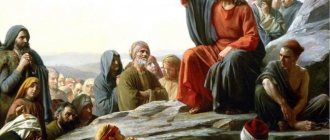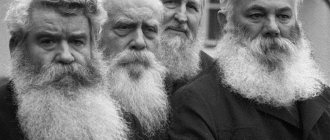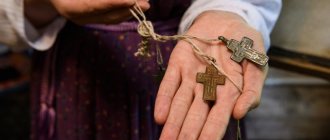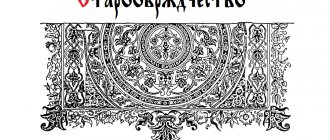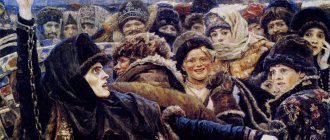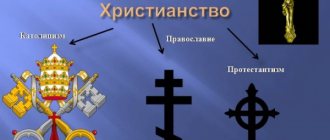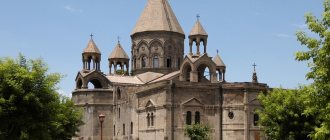The difference between Old Believers and Old Believers
So, first we need to figure out who the Old Believers are and who are the Old Believers. Old Believers are Christians who opposed the adoption of the reforms of Patriarch Nikon. In the 50s of the 17th century, these reforms led to a split in the Russian Church, and those who refused to obey them were declared schismatics, anathematized and oppressed in every possible way. Many died, some managed to flee abroad and continue their family line there. Only in the last century did attitudes towards them soften. A decree of Tsar Nicholas II of 1905 ordered the word “schismatic” to be replaced with the neutral “Old Believer.”
And what did these people rebel against in those troubled times when Nikon split the church? In their opinion, most innovations did not correspond to the truth and desecrated it. For example:
- According to the reforms, the name of God began to be written as Jesus. And the books of old rituals included one “and” at the beginning - Jesus.
- The new canon said to cross with three fingers, and not two, as before.
- Walking around the church was now only possible (counterclockwise).
- The books of worship have undergone serious revisions. In particular, the word “devout” was replaced with “Orthodox.”
Old Believers are those who adhere to pre-Christian views of the world. It would be a big mistake to consider them some kind of ossified, unsociable people steeped in the distant past, who despise modern religion and the way of life in general. These people have a much stronger connection with nature, and their worldview is broader than that of ordinary Christians. They feel like followers of the ancient Slavs, believe in the Slavic Vedas and the special inextricable connection between man and nature. This is the fundamental difference between the Old Believers and the Old Believers, who draw a clear line between the Creator and what he created.
This is what a typical Old Believer looks like
Old Believers are convinced that only by solitude with nature, a person is able to know his true essence and the meaning of being in this world. The Old Believer calendar says that now humanity is going through the era of the Night of Svarog (Kali Yuga), one of the most difficult periods in modern history: economic crises, military conflicts, natural disasters, the triumph of giant corporations. According to the Vedas, everything that happens in the world can be explained, and nothing is accidental.
Consequences of life's mission
Now historians firmly state that if the patriarch had introduced changes gradually, then there would be no such thing as Old Believers. Who they are and what their principles are would not be known to humanity today.
The patriarch's church reform of 1650-1660 was aimed at introducing new and destroying old canons. This became the reason for the emergence of Nikon supporters. On the other side there were adherents of his enemy - Habakkuk. The latter believed that the entries in Russian books better reflected Orthodoxy, and that the Greek works had been incorrectly changed by time.
Regarding the further fate of the man who split the Russian Church, it was disappointing. For a long time, Tsar Alexei Mikhailovich respected the patriarch. But due to the aggressive sentiments of a large group of clergy towards Nikon, their relationship cooled.
In 1666, he was demoted from his position and sent to prison in a monastery. This was partly on the initiative of the sovereign. It is worth noting here that although this person lost his respect, the church did not support the Old Believers, and the laws that the priest so ardently defended were adopted at the official level.
The former patriarch spent 15 years in exile. Before his death, Alexey Mikhailovich asked the priest for forgiveness. The Tsar's son, Fyodor, also felt affection for the priest. He allowed him to return from exile. But on the way the old man died. Despite significant protests from the new head of the church, Nikon the reformer was buried as a patriarch. He was buried in the Cathedral of the Resurrection New Jerusalem Monastery. Fyodor Alekseevich himself read the Apostle over him with tears in his eyes.
Customs of the Old Believers
Old Believers do not have prayers, in the traditional sense of the word. According to them, prayer is something humiliating in relation to both parties: the one praying and the one to whom (what) he is praying. Instead, the Old Believers perform their own tribal rites, but not only a simple layman, but even a representative of another clan cannot know about them. Each clan has its own unique customs, which people keep secret.
Old Believers have a similar attitude towards icons - they consider it idolatry. The walls of their houses are decorated not with images, but with photographs of their ancestors, their letters, and some personal belongings. This preserves the strongest spiritual connection between generations, which for the Old Believers is the basis of their worldview. As does the feeling of belonging to nature.
Old Believers identify themselves with nature, but do not worship it as they worship God
In general, Old Belief is characterized by the absence of general strict rules and dogmas that should be strictly adhered to. It is not necessary to wear special robes or take part in rituals. The main thing for Old Believers is to live according to their conscience, in harmony with it.
A 700-year-long road
The Old Believers trace their history back to the times of Kievan Rus. "Who are they?" is a question that requires in-depth analysis.
The theory of their religion arose immediately after the adoption of Christianity by Prince Vladimir. Then the ruler took Greek Orthodoxy as a basis. Since 988, the inhabitants of the great power began to live according to new laws, which in many ways contradicted paganism.
In the course of historical events, since 1439, the Russian Church fell out of the control of Constantinople and began to develop independently. This happened until Nikon came to the patriarchal throne, who in 1653 again set a course for the Greek canons. Of course, decisive changes in the rules caused significant resistance from the masses, who considered the innovations unacceptable and unlawful. There was a public condemnation of all those who ignored Greek laws and continued to adhere to the rites of their ancestors, which had been known since the time of Prince Vladimir. The manner of prayer, the exclamation of “Hallelujah”, the number of prosphoras and the cross of the Old Believers were changed.
The biggest blow for them was the official adoption of innovations. For some time the country was on the verge of a religious war. Repression and persecution began for all those who were against the new products of the church. From now on, those who disagreed were not only called heretics, excommunicated from the Holy Trinity and bombarded with curses, but also physically exterminated. Moreover, all this was done at the national level and with the assistance of the tsarist government.
What distinguishes the Old Believers from the Orthodox?
It is worth noting that there are several movements among the Old Believers. The two main ones are priests and non-priests. The latter recognize only 2 sacraments: Baptism and Confession (Repentance), in some cases also the sacrament of Marriage and the Blessing of Water. The priests recognize 7 sacraments of the ancient church and a number of less significant sacraments.
In general, all movements of the Old Believers have a common number of fundamental differences from the Orthodox. Here's what they boil down to:
- The cross of the Old Believers has not 4 ends, but 8.
Two more small crossbars are added to the four-pointed cross: a straight one near the top and an oblique one at the bottom
. There are other types of Old Believer crosses, but they are less common.
- The Orthodox use bows to the ground and from the waist, while Old Believers use only bows to the ground.
- These people still make the sign of the cross with two fingers. The Old Believers initially considered the three-fingered sign to be similar to a doula.
- During the service, Old Believers keep their arms crossed on their chests, while Orthodox Christians straighten them at their sides.
- During religious processions, Old Believers walk in a salting direction (clockwise), unlike representatives of the new rite, who walk counterclockwise.
- Adherents of the old rite write the name of God differently. In prayers and holy books, according to experts, there are over 50 different variations.
- Following the old rites means that tobacco and alcohol are a veto. Only a few sects of Old Believers allow the consumption of very small amounts of alcohol on the most important religious holidays - no more than 3 glasses!
Morality in the theory of life
The Old Believers and Old Believers constantly carried all this knowledge with them. Who they are, the features of their faith, the essence of their principles were understood by Catherine II. It was on the initiative of the queen that these people left the cultivated lands and traveled with their families to an unknown destination to the edge of Russia. There they began a new life, albeit difficult, but free and safe.
Their characteristic feature is boundless love for work and God. These are the rules they follow in life. According to their theory, the Almighty created man similar to himself, therefore it is considered a great sin to change something in one’s appearance. Haircuts and shaving are not practiced.
The prayers of Old Believers occupy a special place in life. It is imperative to talk to the Lord in the morning and evening. If it is difficult to find time at the beginning of the day, then you can say the holy words in a minute free from work during the daylight hours.
The clothing of this community is also unique. They dress festively for church. Men wear kaftans, ladies wear sundresses and scarves. Head coverings for married women are mandatory, since open hair and a naked body are considered great obscenity.
Girls learned the art of tailoring from childhood. Usually, before marriage, they did not do heavy housework, but only observed. From childhood, boys were taught to work in the fields and to farm.
Appearance
The Old Believers have huge differences from the Orthodox in appearance. This manifests itself in the following:
- Men should definitely have big beards. Shaving them is strictly prohibited;
- The standard attire for a man is a large, unkempt, untucked shirt, as was worn in Rus' in ancient times;
- The shirt is complemented by a tightened belt. It is endowed with the function of dividing the body into the upper part - the spiritual, striving for the Creator - and the lower part, which symbolizes everything earthly and base;
- No bright colors in clothes! Only strict, one-color things;
- A tie is an unacceptable accessory for an Old Believer. It is associated with Judas, and that is why the tie is called Judas's noose;
- Among the Orthodox, a woman can come to church covering her head with a scarf or scarf tied in a knot. In an Old Believer church, a woman is only allowed to wear a headscarf, which is pinned under the chin.
This is what Old Believers usually look like
Eight-pointed cross
All Old Believer churches have eight-pointed crosses without any decorations. If there is a cross of some other shape on the temple, incl. and with the “crescent”, “anchor”, then this temple is not Old Believer . And the point here is not that the Old Believers do not recognize four-pointed or other forms of crosses, but that due to the persecution of the eight-pointed cross, it was he who received a preferential position in the Old Believers.
|
|
Customs of the Old Believers
The Old Believers had the following customs.
Priests' baptism
Old Believers-priests can perform the sacrament of baptism, if desired, in a natural reservoir or in a font. A priest must perform the sacrament. The exception is a situation when a person is dying and is afraid to leave unbaptized, and an Old Believer priest cannot be found in the surrounding area at that moment. Then the ritual is performed by lay people.
A man plunges into clean water three times. At the first ablution, the priest says: “The Servant of God is baptized ... in the name of the Father, amen,” at the second: “and the Son, amen,” at the third: “and the Holy Spirit, amen.” Bathing in water symbolizes cleansing from sinfulness and union with God.
When baptizing a baby, it is necessary to read prayers to the mother in labor and when naming the baby. This is done so that the mother’s health is strengthened after childbirth, and the child lives her life according to her conscience and deserves the Kingdom of Heaven. On the 8th day, the rite of Confirmation should be performed on the baptized person.
Baptism among the non-priests
Among the Old Believers without priests, the sacrament of Baptism is performed in a similar way. Baptism is also permitted both in a natural reservoir and in a font.
Important! The water in the font should be changed after each baptism so that the person’s sins do not remain there. If an adult is being baptized, then only he and the priest can be present in the room with the font; for an infant, the presence of relatives is allowed.
Three immersions are performed, during which the priest pronounces a blessing. For 8 days after baptism, it is not recommended to wash the body completely and remove the shirt in which you were baptized. On the 8th day Confirmation takes place.
Wedding
The wedding ritual according to the old rite is noticeably different from that accepted by modern Orthodoxy. The table shows their difference.
| Old rite | New rite | |
| Reading the Apostle and the Gospel | At the beginning | After laying the crowns |
| Singing Psalm 127 | Choruses were added that were not in the old rite | |
| Questions to those getting married about the voluntariness of their intentions | No | Eat |
| Registration at the Civil Registry Office | After the wedding | Before the wedding |
| A warrior on the bride's head | Worn at the end of the engagement | Not used |
Marriage of an Old Believer couple
Funeral
It is customary among Old Believers to bury the deceased on the 3rd day. On the eve of the burial, on the morning of that day and before the burial, memorial services are held. The longer the funeral service lasts, the purer the soul will appear before God. Only those who lived their lives with dignity and righteousness deserve a funeral service.
The head of the deceased in the coffin should face west, the legs should face east. At the funeral, the last service, Lithia, is held. After it, the symbols of faith are taken out of the coffin, nailed up and lowered into the ground. Old Believers do not have a wake immediately after a funeral. They are carried out on days 3, 9 and 40 after death.
In the rhythm of time
The Orthodox Old Believers were perceived by the authorities as a political movement that played the role of opposition for the imperial court. And indeed, as soon as Catherine II gave them official permission to build churches, this movement founded and organized its own city in a short period of time. Today it is located on the territory of Belarus. In the 18th century there were about 5,000 Old Believers there.
Some of these people were killed by order of the queen. All who remained alive were forcibly resettled to eastern Russia. Their descendants still live there. Today they are known under the name Semeyskie.
It should be noted that other religious minorities, from Protestants to Buddhists, received government support.
According to official sources, in the 19th century, a third of the population of the Russian Empire still lived according to the rules of their ancestors, who were baptized in Kievan Rus.
Later, the authorities began to be more loyal to this trend. The question arose more and more often: “Who are the Old Believers?” Their customs and canons were not considered as those that could damage the integrity of the state. But they were prohibited from building temples, printing books, disseminating teachings, and even holding high positions. Even marriage was illegal for couples.
At the beginning of the 1900s, the rights of this denomination were equal to those of other religious minorities.
How Old Believers pray
It is known that followers of the Old Believers prefer to cross themselves the way their great-great-grandfathers did, that is, with two fingers. After Nikon's reforms, the two-finger sign was replaced by a three-finger sign, which symbolizes the Holy Trinity: God the Father, God the Son and God the Holy Spirit. The Old Believers believe in the One God the Creator, and do not attribute divine properties to the mortal Jesus and, in their opinion, to the Holy Spirit invented by Christians. The larger of the two fingers in their sign is endowed with the symbolism of God, while the smaller symbolizes the prophet of God Jesus of Nazareth.
The Old Believer folded his fingers for the two-fingered sign
Bows at Old Believer services can only be made to the ground; waist bows are prohibited. Prostrations are divided into 4 types:
- usual - bow to the breasts or to the navel;
- medium - to the waist;
- “throwing” (from the Greek metanoia - repentance) - a small bow to the ground;
- proskynesis - a great bow to the ground, with kissing feet.
Through the centuries
Today, science is especially interested in a phenomenon called “Old Believers.” Who are they? The photo in the material shows communities from different parts of the world, but they are all united by deep family values.
These people lead a closed lifestyle, rarely give interviews and believe that being on camera is unkind. They believe that photographs take away the divine energy that is stored in the human body. But without alien, unusual equipment, they are good-natured, friendly and pleasant.
Many families still live without electricity or the Internet; they are not interested in the crisis and defaults. Previously, Old Believers did not use money, did not buy clothes, food, medicine, and did not even eat overseas potatoes. They do not visit hospitals and very rarely enjoy the benefits of civilization.
The community lives by its own rules. The father of the family sits down at the table first. Everyone is praying. They all leave the kitchen together. A man should not see how food is prepared, so the door to the room where it is prepared is covered with cloth.
Unneeded by either the church or the state, they managed to preserve the identity and spirituality that the first Christians of Kievan Rus inherited to them. These are people who did not know such vices as alcohol, tobacco and entertainment. But they preserved the science of antiquity. The secret of the past lurks in their souls.
Can an Old Believer be godfather to an Orthodox Christian?
A person is going to baptize his child, and intends to make a good, trusted friend as godparent. Everything would be fine, but they have a fundamental difference in their worldview: one is an Orthodox Christian, the other is an Old Believer. How to resolve this situation?
This option is possible only in one case. The second godfather must be Orthodox, and the Old Believer godfather must promise that he will not in any way interfere with the child’s upbringing according to the traditions provided for by the current Orthodox canons.
Inside the Old Believer Church. Helpers
In Old Believer churches you can also find handicrafts - special rugs for bowing to the ground. Handicrafts, as a rule, are folded into neat piles on the benches of an Old Believer church.
Handles for prostrations. Rogozhskoe
Contrary to popular belief, supposedly in Old Believer churches there are never chairs or seats (like Catholics or Uniates), in fact, such seats are available in many (but not all) Old Believer non-priest churches in the Baltic countries.
Old Believer Church without Priest
From Prince Vladimir to Patriarch Nikon
Baptism
In the Russian Orthodox Church, since the enlightenment of Russia, St. baptism in 988 under St. Prince Vladimir, the Greek-Eastern confession and ritual piety were established, preserved unchanged, in detail, for 7 centuries. In this seven-century space, there were two tangible misfortunes in the Russian Church. This heresy of the Judaizers and Strigolniks, which did not spread, soon disappeared. This was not the case in other countries. To a greater or lesser extent, they are damaged in Orthodoxy by false teachings, errors, either voluntarily, like the Roman Church, or forcibly, like the Greek, thanks to the oppression of the wicked Turks and the machinations of the Roman Church.
Were there many wealthy entrepreneurs and philanthropists among them?
Representatives of four branches of the Morozov family. Early 1860s - From left to right: Abram Abramovich Morozov (left), Timofey Savvich Morozov (sitting in the center), Ivan Zakharovich Morozov and Vikula Eliseevich Morozov. Church of the Dormition of the Blessed Virgin Mary in Putinki
There was such a phenomenon as the Old Believer merchants. Discipline, strict rules, which extended to the business sphere, mutual assistance - all this contributed to economic success. Thanks to mutual responsibility and tribal solidarity, Old Believers communities could play the role of banks, entering into financial relations on parole. The Old Believers took care of their workers: they built hospitals, almshouses, and libraries. The literacy rate among Old Believers as a whole was higher than in the country.
Old Believer communities were very rich, and their members played an important role in the development of Russian industry. The Morozovs, Ryabushinskys, Gromovs, Avksentievs, Buryshkins, Guchkovs, Konovalovs, Prokhorovs, Soldatenkovs, Tretyakovs, Khludovs, Bugrovs - all these are Old Believer dynasties. With the introduction of religious tolerance and the constitutional principles of the monarchy in 1905, Old Believers-entrepreneurs tried to become the basis of young Russian capitalism.
